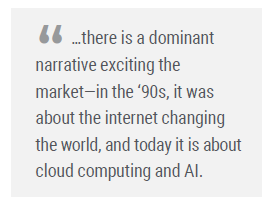
Brent Fredberg is a Director, Investments Group, a Senior Analyst and leader of the Technology Research Team. Mr. Fredberg sits on the Consumer Products Research Team, with a primary focus on household durables companies. He is a member of the Global Large-Cap Investment Committee and the Investment Oversight Committee. Mr Fredberg is a limited partner of the firm’s parent company.
Before joining Brandes, Mr. Fredberg was a Financial Analyst and Controller with Raytheon/Amana Appliances. He earned his MBA with distinction from Northwestern University’s Kellogg Graduate School of Management and his BS in finance with distinction from the University of Iowa. Mr. Fredberg is a CMA (inactive). His experience began in 1994 and he joined Brandes Investment Partners in 1999.
In the past year, the financial landscape has been marked by rising interest rates and growing buzz around technological innovations, particularly in artificial intelligence (AI). To delve into what these developments could mean for value investors, we spoke with Brent Fredberg, a technology analyst and member of Brandes’ Global Large-Cap Investment Committee. Brent sheds light on navigating today’s interest rate environment, parallels to the 1990s tech bubble that he is witnessing, and the sustainability of value’s recent performance. Brent has 29 years of experience and has been with Brandes for 24 years.
There has been a lot of rhetoric surrounding ”higher-for-longer” interest rates following the Federal Reserve’s historic rate increase, where we have observed the 10-year Treasury yield rising from about 1% a few years ago to roughly 4-4.5% today. And while inflation is coming down from recent peak levels, there is the potential for structurally higher inflation than we experienced over the past decade due to the reshoring of manufacturing, the escalating costs of clean energy, and the substantial Treasury debt issuance required given the fiscal and monetary stimulus during Covid-19. These factors can create inflationary pressures that counterbalance the productivity gains typically achieved through technology and AI advancements.
Historically, the performance of global value stocks has positively correlated with high or rising interest rate environments. This correlation arises in part because the higher the interest rate and discount rate, the more challenging it can be for longer-duration growth stocks (those whose market value depends on more distant future cash flows), as these discount rates affect the present value of their future cash flows.
In the past, we have talked about this theme of ”Goliath wins” as it regards the banks, with larger, scaled banks being advantaged in several ways versus smaller banks. In today’s environment, we are also concentrating on ”balance sheets win.” This approach means we are prioritizing companies with what we consider robust financial health and strong balance sheets. In this interest rate environment, companies with heavy debt burdens tend to face increased pressure as they refinance their debt at higher rates. Therefore, we are being more selective, trying to avoid companies that appear ”cheap” but have financial structures that could pose significant risks, particularly if an economic downturn occurs.

While it may surprise some to hear this from a value perspective, I do not believe the tech sector is in a bubble per se, although I think it is fair to say tech valuations in general appear quite full. I was a tech analyst at Brandes during the height of the tech bubble in 1999, and today’s tech sentiment and valuations do not appear quite as excessive as back then. With that said, there are some parallels with the late ‘90s. Firstly, similar to that period, tech valuations are at a significantly higher premium compared to the broad market than we are used to seeing. Secondly, we have experienced aggressive interest rate increases by the Fed. And finally, there is a dominant narrative exciting the market―in the ‘90s, it was about the internet changing the world, and today it is about cloud computing and AI.
Despite tech generally being expensive, the sector’s valuation is bifurcated. We have been able to find a number of opportunities to invest in some of these secular themes, such as AI, in ways that are lower-profile, less popular, and appear to be better values from our perspective. For example, AI requires a very large amount of memory semiconductors (e.g., DRAM chips) to do its processing, so Brandes has invested in a number of leading DRAM manufacturers across the world. We also own a Taiwanese foundry producing AI chips, a European software company using AI to enhance customer decision-making, and an IT services company helping customers transition to the cloud and incorporate AI technologies. I would not paint all of tech with the same brush, even though, in general, the sector seems suboptimally priced for performance from this point.
As a firm, we do not think the value run is over. Historically, since the 1970s, shifts between growth and value regimes have lasted many years. On average, value regimes have lasted about six to eight years, and we are just three years into this current value period.1 Nevertheless, it is not uncommon to have extended periods of growth outperformance during these multi-year value regimes.
For example, after the late ‘90s tech bubble, from 2000 to 2002, a stronger period for U.S. value stocks relative to growth, there were six periods during that time when the Russell 1000 Growth outperformed the Russell 1000 Value by over 10 percentage points, three of which exceeded 20 points. Despite this, the value index outperformed over the subsequent four years. From that perspective alone, we do not find the recent trend overly concerning.
Also, there are also several potential catalysts for value that exist today, but one that we talked about earlier is this interest rate environment, and a return to what we consider a more legitimate cost of capital. Interest rates do not need to remain at these levels, but instead just a more normal interest rate environment, unlike the abnormally low and negative real rates of the past decade, helps remind the market that valuations matter.
Most importantly, the valuation gap between value and growth is very wide, near historic levels. If you look at a composite of various metrics (e.g., price to earnings, price to book, price to cash flow, and enterprise value to EBITDA), value is less expensive relative to growth than it has been in 50 years, with the exception of the Nifty-Fifty era (late ‘60s and early ‘70s) and the late ‘90s tech bubble. And not only does value appear to us to be quite attractively priced relative to growth, it also looks reasonably valued on an absolute basis. For these reasons, we do not think the value run is over. Instead, we think value provides an attractive opportunity in today’s environment and could potentially help mitigate some risks that may exist in the rest of one’s portfolio.
